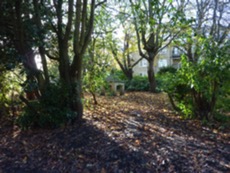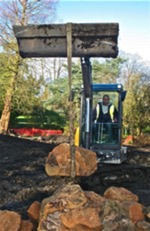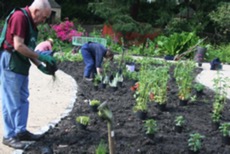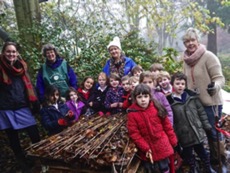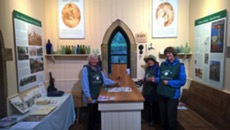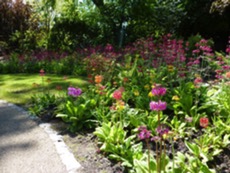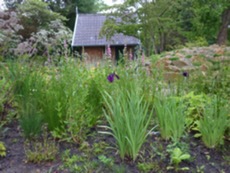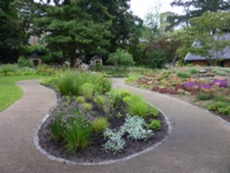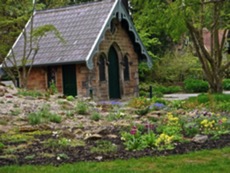Entry for Yorkshire in Bloom Open Spaces Category
Peat Garden and Old Magnesia Well Pump Room,
Valley Gardens, Harrogate
Introduction
By 2011 the gothic style Old Magnesia Well Pump Room (OMWPR) built in 1858 and its rock garden (built in 1906/07 to cover a reservoir used to store the magnesia water) were in disrepair and the surrounding garden overgrown. The garden has a magnesia well and a chalybeate well. Friends of Valley Gardens (FOVG) in partnership with Harrogate Borough Council (HBC) began restoration work on the building in 2012 and the rehabilitation of the garden the year after.
The aim was to restore the spa heritage and renew the garden and use the interior of the building as an information and education centre.
Community
The work on the building, paths and garden was carried out by the Friends of Valley Gardens, working with the Council and local contractors, following public consultation on the plans.
The Friends obtained funding from ASDA, Charles and Elsie Sykes Trust, Duke of York Community Initiative, Farrahs, George Martin Trust, Hale’s Bar, Harrogate Mumblers, Harrogate Spring Water, Harry Bolland Trust, Harrogate Borough Council Arts & Heritage Fund, Liz and Terry Bramall Charitable Trust, the North of England Horticultural Society, Menwith Hill, Heartbeat, Morrisons, Newnham Street garage, North Yorkshire Community Fund, WREN, the Yorkshire Building Society and funds raised by the Friends of Valley Gardens.
FOVG hold an annual 1940s day in the Gardens (27,000 attended in 2015) to raise funds and also man the OMWPR on Heritage Open Days and on the first Sunday of the month. They also raise funds through guided tours of the gardens, coffee mornings, bag packing and the Waitrose green disc scheme.
Western Primary School children planted spring bulbs (anemone, narcissus, snowdrops, winter aconites, and cyclamen) in the garden.
An opening ceremony was held for the OMWPR in October 2015, the ribbon cut by an eminent local historian and attended by the Mayor and lady Mayoress.
National Nest Box Week was celebrated this February by Horticap students building; the boxes were installed by the Council’s arboriculture team assisted by the Horticap students, with advice from Harrogate District Biodiversity Action Group.
FOVG have a web site and also face book and twitter upon which information about the garden and events is put. Local newspaper coverage was achieved for all four of the events described above.
The FOVG volunteers carry out gardening tasks with the HBC every fortnight and on occasion weekly at peak work loads. They have been intimately involved with the Peat Garden rehabilitation including site survey, design, plant sourcing and planting and the management of the construction of the rock garden.
Maintenance and development
The volunteers maintain the peat garden with the HBC gardeners and have a management calendar and more detailed lists of the individual plants with information on them, including maintenance.
The OMWPR is on HBC’s asset maintenance plan and the FOVG volunteers regularly check condition and clean out the gutters.
Arboriculture
Old, densely crowded or diseased trees and shrubs were removed by the Council’s arboriculture team and local trees contractors. To retain pant structure some of the species rhododendrons and azaleas were retained and some cut back to enable sprouting from shoots lower down.
Lower branches of the cherry trees were pruned by the Council, working with the volunteers to enhance vistas to other heritage features in the gardens.
Some sympathetic pruning of shrubs, such as Viburnum, is also carried out by the volunteers.
Conservation
Planting schemes were devised to include a mixture of native and non-native plants attractive to pollinators.
No original designs could be located for the original rock garden so the design reflected the scale and environmental conditions of the garden and the philosophy that might have been applied had it been designed by the James Backhouse Nursery of York.
Western School children spent a day building a bug mansion and piles of logs and twigs to help invertebrates, frogs and hedgehogs.
The Valley Gardens are Grade II listed and the OMWPR was restored in consultation with English Heritage and as far as possible in keeping with the original photographs of both the exterior and interior of the building.
Reclaimed stone from a Lancashire mill was used for the paving around the pump room.
Groundsmanship
There is a management calendar for the garden and plant listings with the conditions they prefer and maintenance notes.
FOVG volunteers meet fortnightly on a Tuesday to carry out gardening tasks in the Valley Gardens, including the Peat Garden where additional routine maintenance work is also carried out.
Their work includes weeding, digging, adding fertiliser where appropriate, top dressing and propagating, moving, dividing and replacing plants and watering as necessary. A water supply was installed for the latter.
When the garden was developed, bricks, concrete pieces, glass and old railings had to be removed from the site and the soil rotovated and graded. Some areas were then seeded with a shade grass mix. Manure was dug into parts of the woodland and the ground rotovated.
The grass is regularly cut by Council staff and where drifts of bulbs have been planted grass cutting takes place after the leaves have died back. Grass edges are cut by the volunteers.
The resin surface paths installed through the garden are accessible to all and regularly brushed at volunteer days.
Horticulture
Consideration was given to the gothic style, scale and magical, informal atmosphere of the Peat Garden; and also to aspect and ground conditions.
The history of the garden was identified as far as possible from old photographs and personal information from the Valley Gardens gardeners present and past.
Design and planting lists were developed from an initial outline design, by sketching the site, annotating onto photographs and looking at the vistas. Colour combinations, plant structure and height and growing conditions were all considered as well as interest through the seasons.
FOVG visited and sourced the plants from nurseries and plant fairs in the north, including local nurseries and Horticap, also gaining inspiration from what was available.
Rock garden advice was obtained from alpine experts and library searches. The rock garden ground was prepared using a pea-gravel and grit sand mixture with the soil in the garden and pea gravel top dressing. Local stone similar to that used for the OMWPR, and quarried locally in the past, was used for the rocks.
Sketches were also made of local landscape features such as Almscliffe and Embsay Crags to inform the shape of the rock garden; inspiration for the woodland originated from a visit to a local private garden open for group visits.
Environmental
The sandstone for the rock garden was sourced from a local stone yard, adding to that available already on site which was re-used.
During the winter storm damage logs collected in the gardens are added to the wildlife log pile and the cut stems of some of the perennials used to supplement the bug mansion.
Some fallen leaves in the autumn and plant material are left to over-winter for the invertebrates and any compost needed sourced from HBC.
Spent coffee granules obtained by HBC were spread around the hostas to deter slugs and snails.
Littler and dog mess in the garden is removed during volunteer gardening days and litter regularly managed by HBC.
The Pump Room and Well Heads condition is regularly checked by the volunteers and any issues reported to HBC.
The OMWPR recreates the days of magnesia water dispensing and also houses display boards about its use, the spa heritage of Harrogate and the development of the Valley Gardens.
There is also an external display board about the garden and its heritage.
The FOVG volunteers sourced the artefacts of the OMWPR to recreate the scene of dispensing magnesia water and provided the photographs and text for external and internal display boards. The old sink produced by the Leeds Fireclay Company Ltd. was re-used. They also produced an information folder about the work carried out for both visitor and archive purposes.
The garden is regularly visited by many local residents of all ages, visitors from around the UK and from abroad on a daily basis through the year (around 3 million people visit the Valley gardens each year). Many pass the peat garden on the route to Harlow Carr Gardens through the Pinewoods. Local people of all ages have enjoyed watching the garden and OMWPR develop.
The garden, which includes a sensory garden, is accessible to wheelchair users (apart from two steps essential due to the gradient of the land) and the paving has a contrasting edge.



